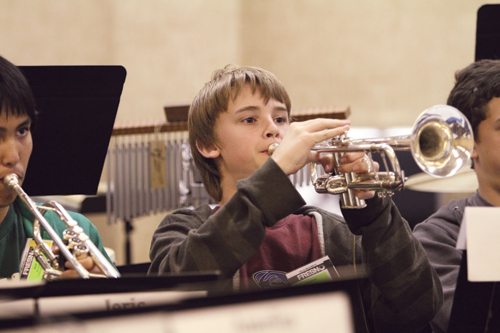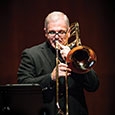
Multiple tonguing is a mysterious and frightening concept for many young brass players. While diligent practice is necessary to master them, the concepts of double- and triple-tonguing are quite simple. Here are some of the basics of double- and triple-tonguing, how they are executed, and how to help young students get started.
When to Start
Although multiple tonguing is sometimes considered an advanced topic, I have found that students who are introduced to this skill in middle school year learn it more easily than those who begin in high school or college. Once a student can single tongue sixteenth notes at a moderate tempo it is time to attempt multiple tonguing. Initially this might be best accomplished through imitation and rote exercises instead of presenting written music that may be beyond young students’ reading ability.
Choosing Consonants and Patterns
With regard to which consonants should be used in multiple-tonguing, brass players and teachers sometimes debate whether ta-ka or da-ga is best. While some advocate strongly for one pair of consonants or the other, I leave this question to personal choice. The action and placement of the tongue between the two are really not that different, and differences in dialect and language can mean that one person’s da is harder than another’s ta. An individual player might even choose to use ta-ka in some situations and da-ga in others. As long as students understand that they are striving for an alternation between a normal tongue strike behind the upper teeth and a second articulation towards the back of the mouth, I see no harm in allowing them to decide whether ta-ka or da-ga works best for them.
A more difficult question is determining the pattern of syllables used. For double-tonguing this should be obvious; the pattern is ta-ka (or da-ga). For triple-tonguing, however, there are more options available. Most brass method books suggest the pattern ta-ta-ka or da-da-ga, and many teachers require all students to use this pattern. I have found, though, that some students succeed more with the alternative pattern ta-ka-ta (or da-ga-da), and thus I allow students to choose the pattern they prefer.
An additional possible pattern for triple-tonguing that I do not allow is simply double-tonguing and then placing accents to create the triplet feel (TA-ka-ta-KA-ta-ka). In practice the intended triplet feel is rarely achieved using this pattern.
Strengthening the Ka (or Ga)
Inevitably, the notes articulated with the ka/ga syllable are weaker and less consistent compared to those articulated with ta/da, at least when first beginning to multiple-tongue. To correct this, first have the student place the ka/ga syllable more forward in the mouth. This is in some ways a mind trick as much as a reality, but it makes that syllable crisper and helps avoid the tendency to swallow it, which reduces clarity.
Second, use slow exercises that isolate the ka/ga and which aim to promote matching of the ta/da and ka/ga sounds. Here are a few examples, which can be played on single pitches (my preference) or in patterns of multiple pitches:



Third, practice multiple-tongued passages with accents on the ka/ga syllables. This is easier to do slowly, and as speed increases the accent becomes almost imperceptible. Still, merely thinking about an accent on the weaker syllable helps bring it to the place where its sound matches that of the ta/da syllable.
Improving Tone and Response
Often young students learn to multiple-tongue fairly rapidly but the sound is choppy and noticeably inferior to that produced when single-tonguing or slurring. To solve this problem, have students blow multiple-tongued passages the same way they would slurred or legato passages. While multiple-tongued passages usually call for more of a staccato articulation, the rapid tonguing is usually sufficient to create the needed detachment, and thinking of legato air ensures that the notes will still have enough length to have a full sound.
Response problems often result when the inside of the mouth is too large or too small for the desired pitch because of which vowel sound a student is trying to produce. While many teachers and players advocate using various vowels to aid in moving between registers (for example, oh for lower notes or ee for higher notes), students who use these in other situations will sometimes abandon them when multiple-tonguing, leading to difficulties when multiple-tonguing in the higher and lower registers. Ta-ka should be modified to tee-kee, toh-koh, or any other vowel shape that produces the desired pitches more efficiently.
Increasing Speed
Ultimately, multiple-tonguing exists to enable faster playing, and the metronome is the best tool to measure progress and promote further development in this respect. Have students determine the fastest speed at which they can successfully perform assigned multiple-tonguing exercises, and then every 2-3 days increase that speed by 1-3 beats per minute. Using the metronome whenever practicing multiple-tonguing promotes measured development of this technique, preventing erratic changes in tempo from day to day while ensuring steady, incremental progress.

Suggested Materials for Practice
Every brass player’s daily fundamentals routine should include at least a bit of multiple-tonguing, as even after this technique is mastered the player’s abilities will decline rapidly without daily maintenance. At minimum, I will include the following pattern in each day’s practice, performed on each note of a selected major scale, with the eighth notes single-tongued, the triplets triple-tongued, and the sixteenth notes double-tongued. I will set the metronome just a few clicks beyond what is comfortable, but not to a speed that is altogether impossible.
For more extended practice, the multiple-tonguing exercises in the Arban method are extensive, thorough, and progressively arranged. Any of the multiple available editions for trumpet/cornet, trombone/euphonium, and tuba will suffice; horn players can use a trumpet/cornet edition with little difficulty.
Multiple-tonguing can be difficult, but its simple underlying concepts can be mastered by any brass player with diligent and systematic practice. The tips and techniques discussed here will help even the youngest brass players to get their multiple-tonguing practice off to a good start.






